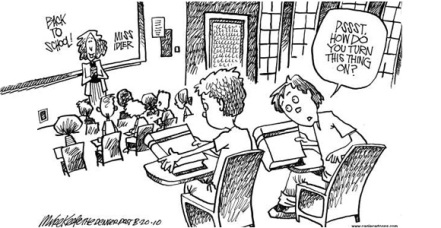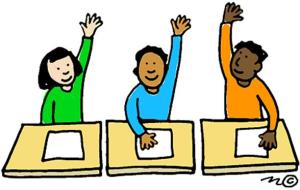Classroom Tips for Deepening Student Understanding through Questioning
We live in a sensory overloaded world. Electronic devices or the drama of real life can easily distract our students. It is important that we find ways to actively engage learners so that they have the space to explore their intellectual curiosity and deepen their content understanding. To do this well, we teachers must ask our students questions! We need to get them thinking about complex concepts and talking to each other as they grapple with them.

Students want to learn from each other. They want to share their own views and perhaps even argue about other’s. Stimulating conversation about things students care about is what will hold their attention and ultimately deepen their content understanding.
When competing with the sensory-overloaded world out there, it is important that teachers show students that we want to hear what they have to say, and facilitate open and exciting discussion.
How do we do this? We ask them open-ended and intentional questions, get them asking their own, and get them to investigate together. Ask, ask, ask away and get them to engage deeply with the content at hand.
1.) Engage students and informally assess their comprehension by asking questions and stimulating dialogue.
Use preplanned and guiding questi ons as you go. Avoid trick questions and phrase questions clearly and concisely. Ask questions that engage student interest; relate them back to their worlds. Think music, politics, social issues, etc..! Listen carefully to their responses and ask follow-up questions to encourage open conversation. (Caram and Davis, 2005).
ons as you go. Avoid trick questions and phrase questions clearly and concisely. Ask questions that engage student interest; relate them back to their worlds. Think music, politics, social issues, etc..! Listen carefully to their responses and ask follow-up questions to encourage open conversation. (Caram and Davis, 2005).
2.) When asking these thought-provoking and open-ended questions, have students talk in pairs before opening up full-class discussion.
Students are often nervous to pipe up without having a moment to reflect on the question their teacher has just asked. By asking that students turn and talk to the person next to them about the question at hand, students get to put their ideas into words and learn from their partner before having to share with the class. This simple routine gives students confidence to speak up in classroom discussion, and enhances the quality of classroom discussion overall.
3.) In order to elicit deeper critical thinking, stimulate conversation between students!
Instead of asking just one student to respond to an open-ended question, be sure to ask other students if they agree or disagree, and why. You can also hold students responsible for listening to each other by asking that students restate what their classmate has said, and following that up with questions about their own opinion on that response (Goldsmith, 2013). This way we get students responding directly to the ideas of their classmates.
4.) Avoid the traditional raise-your-hand to respond method. Hold students responsible for classroom engagement.
Especially if teachers use the turn-and-talk method after asking each question, students should feel prepared with a response. Cold-calling holds students responsible for classroom engagement. It also helps ensure that students who are more timid and less likely to pipe up have the opportunity to share their ideas with the class.
 5.) Host Socratic seminars, and stimulate “conversations that teach” (Roberts and Billings, 2009, p.83).
5.) Host Socratic seminars, and stimulate “conversations that teach” (Roberts and Billings, 2009, p.83).
As said, questioning deepens content understanding, as students are held accountable for their own engagement. It also provides the teacher with important information regarding student comprehension. So, get students to ask their own questions! Host Socratic seminars and teach students what are factual, interpretive, and evaluative questions. Listen carefully as they go to get a sense of how they are grappling with classroom texts and ideas.
To teach students factual, interpretive, and evaluative questioning, begin with a fun, recognizable story like Cinderella and ask students to come up with each type of question based on that story. Then, ask that they apply this questioning method to the texts read in class.
Whenever hosting a Socratic seminar, give students time (either in class or at home) to prepare by developing their own questions. Encourage them to ask questions that refer directly to the text and deepen textual understanding.
6.) Set up Structured Academic Controversies (SACs) in the classroom to get students to work together to investigate questions on their own.
The SAC allows students to explore a complex question in teams. In pairs, students are assigned a certain position related to a question. For instance, the teacher may ask: Was the New Deal a success or failure? One pair of students must find evidence for it being a success, and the other pair must find evidence for it being a failure. After, both teams must present their evidence to each other, and then must come to a consensus as a group regarding their own position on the issue.
In a SAC, students do not have to choose one position for their consesus, but can develop more complex, fuller answers to the question. For instance, they may decide that the New Deal was successful in that it treated the symptoms of the Great Depression, but was a failure in that it did little to address the root causes.
Students don’t easily forget the conclusions they came to on their own. Ask them the right, tough questions to get them investigating together!
References
Billings, L. & Roberts, T. (2009). Speak up and listen. Kappan Magazine, October 2009 ed., pp. 81-85.
Caram, C & Davis, P. (2005). Inviting student engagement with questioning. Kappa Delti Pi Record, Fall 2005 ed., 19-23.
Goldsmith, W. (2013). Enhancing classroom conversation for all students. Kappan Magazine, April 2013 ed., pp. 48-52.